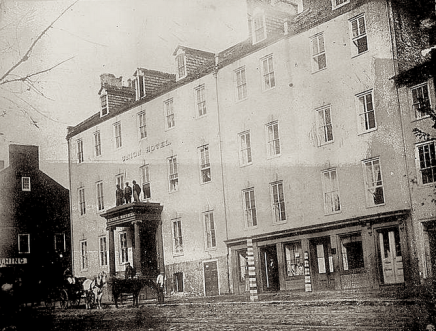30th & M Street: Into the Maelstrom of War, Twice

Originally named The Crawford Hotel and then renamed The Union Hotel during the Civil War, this was a prominent hostelry that served some of the city's most distinguished visitors starting before the The War of 1812. During the American Civil War, it was commandeered and used as a Union hospital, not unusual for the time or the location.
The photo above depicts the now complete renovation of the hotel soon after the Civil War and she is sporting a new French Mansard roof which became a trademark style and a key indicator to later historians that would be known as Second Empire; a roof form that would go viral across the northern and western United States.

The photo at right is referenced in another source as being taken "in the aftermath of The Battle of Fredericksburg" which reliably dates it. The hotel is clearly being used as a hospital; windows are open in winter because of the humanity and smell, men stand about, soldiers are looking out the windows at the photographer in hopes of being recorded before they possibly die.
Just 49 years earlier, British soldiers would have seen this building from the same view as they nervously halted their chase of the retreating American forces from Bladensburg. They stood on the threshold of Georgetown at the then "Aqueduct Bridge" on Pennsylvania Avenue fearing that the heathen-rascal citizens of Georgetown would 'open up' on them from their houses and shops- and these British were hardened veterans just off the ships from fighting in the Napoleonic Peninsular Campaign.
They shouted jeers and insults at the fleeing Americans at this location, shooting, throwing rocks and bottles and pumping fists in the air. From the ranks, speculation that the reason the Americans fled so quickly and surprisingly from the battlefield was to lure the British out of the city into Georgetown where they could be encircled. It was not true.

It was a hot and humid night and the weather was turning ugly as Washington summers can be. Some hours later, approximately 120 British soldiers would be killed, far more than by enemy fire, by a freak tornado that walked itself right up the mall and Capitol and extinguished much of the set fires and putting the fear of God in the occupiers, who then abruptly departed back to their boats at Benedict, Maryland.
In truth, only about 60 men with a few small artillery pieces were able to re-muster after the retreat at the hill forest that is The Georgetown Library today. The British never came, but vowed to come back after the winter and finish Georgetown for good.
Colonial Jackson in New Orleans saw to it that they couldn't keep their promise and thus was written the popular song of the whole affair:
"In 1814 we took a little trip-
Along with Colonial Jackson down the mighty Miss-is-ipp,
We took a little bacon and we took a little beans,
We caught the bloody British in the town of New Orleans."
Simon Jacobsen is the curator of the popular blog "Vanished Washington" and is partner of the Georgetown architecture firm Jacobsen Architecture with his father Hugh Newell Jacobsen.




